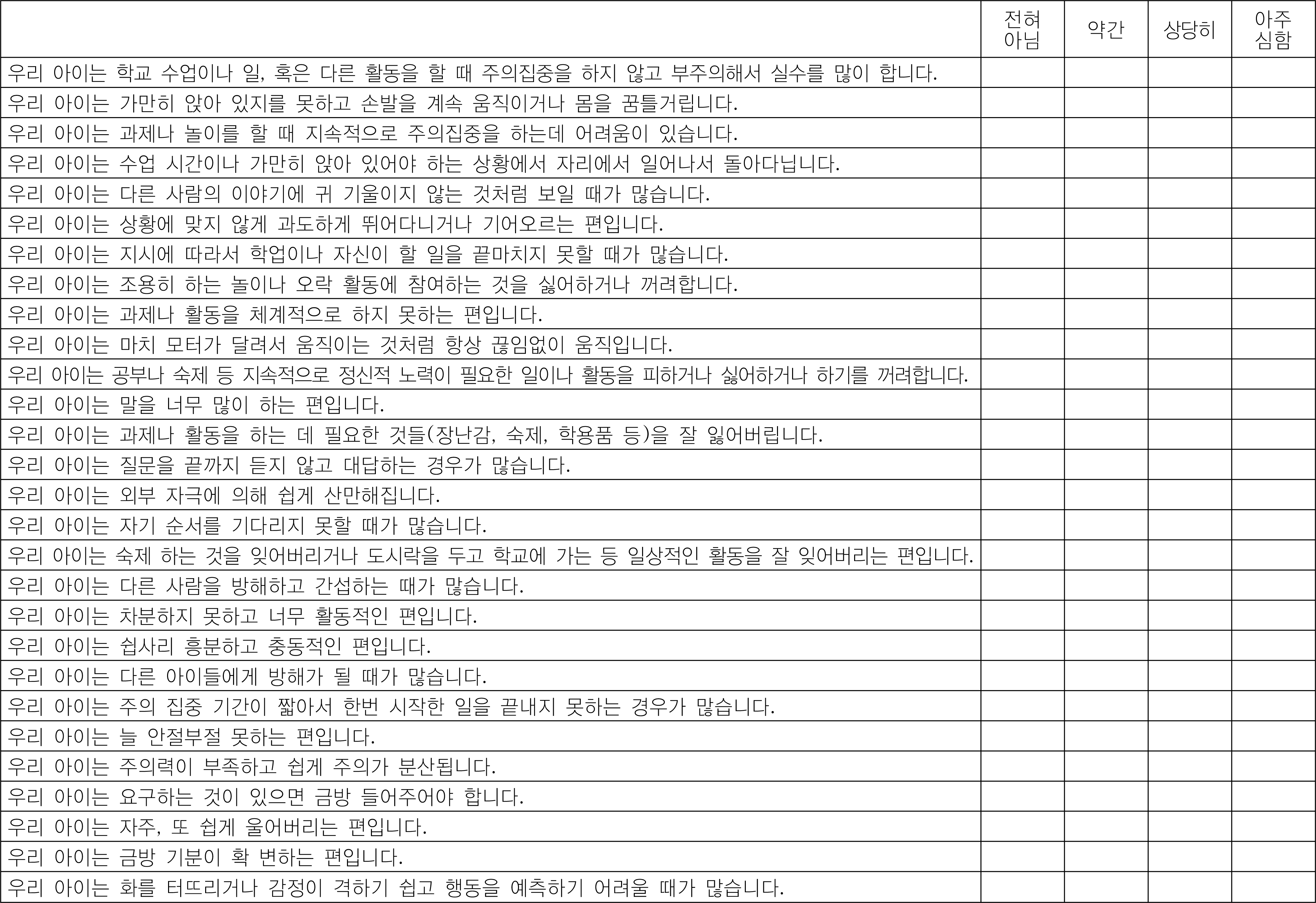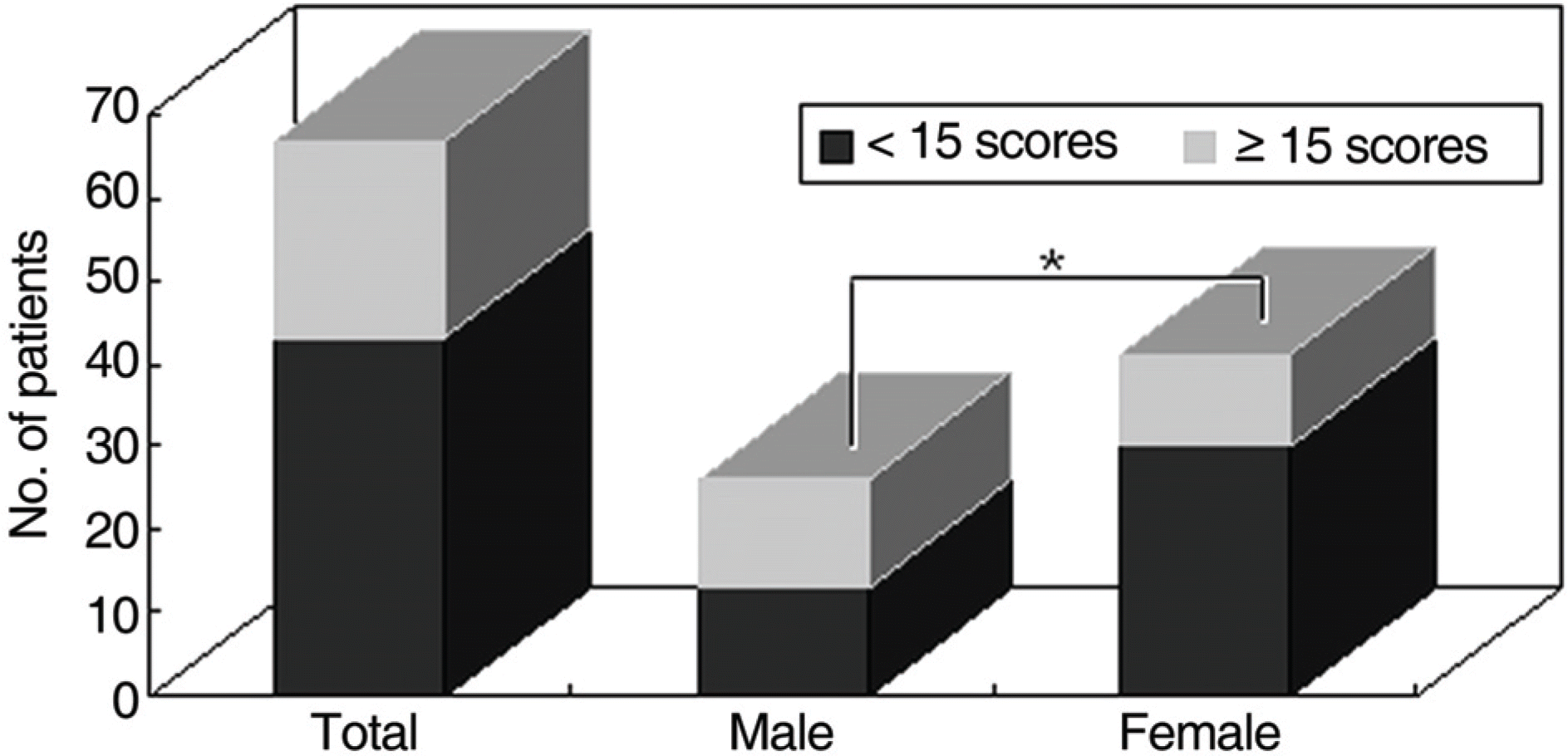Abstract
Purpose
To evaluate the effect of strabismus surgery in exotropia patients suspected of attention deficit hyperactivity disorder (ADHD).
Methods
Parents of 67 exotropia patients answered the Conner Teacher Rating Scale-Revised for suspecting ADHD before and after 3 months of surgery. Patients were divided into 2 groups by preoperative scale scores. Group 1 had scores under 15 and group 2 who were suspected to have ADHD had scores above 15. Characteristics of exotropia and scale score differences were evaluated.
Results
Group 1 had 43 patients and group 2 had 24 patients. The ratio of group 2 was significantly higher in boys than in girls (P=0.048). The scale scores increased by 1.30 points in group 1 and decreased by 1.04 points in group 2 but there was no significant difference. Scale scores in each group showed no significant difference according to surgical outcome.
References
1. American Psychiatric Association. Diagnostic and statistical manual of mental disorders: DSM-IV-TR. 4th ed. Text revision. Washington DC: American Psychiatric Association;2000. p. 85–93.
2. Jensen P, Kettle L, Roper M, et al. Are stimulants overprescribed? Treatment of ADHD in four U.S. communities. J Am Acad Child Adolesc Psychiatry. 1999; 38:797–804.

3. Goldman L, Genel M, Bezman R, Slanetz P. Diagnosis and treatment of attention-deficit/hyperactivity disorder in children and adolescents. JAMA. 1998; 279:1100–7.

4. Leslie LK, Weckerly J, Plemmons D, et al. Implementing the American Academy of Pediatrics attention-deficit/hyperactivity disorder diagnostic guidelines in primary care settings. Pediatrics. 2004; 114:129–40.

5. Cho SC, Shin YO. Prevalence of disruptive behavior disorders. J Kor Acad Child Adolesc Psychiatry. 1991; 41:147–259.
6. Kim YS, Yu So YK, Noh JS, et al. Normative data on the Korean ADHD Rating Scales (K-ARS) for Parents and Teacher. J Korean Neuropsychiatr Assoc. 2003; 42:352–9.
7. Mostoofsky SH, Lasker AG, Cutting LE, et al. Oculomotor abnormalities in attention deficit hyperactivity disorder; A preliminary study. Neurology. 2001; 57:423–30.
8. Gould TD, Bastain TM, Israel ME, et al. Altered performance on an ocular fixation task in attention-deficit/hyperactivity disorder. Biol Psychiatry. 2001; 50:633–5.

9. Feifel D, Farber RH, Clementz BA, et al. Inhibitory deficits in ocular motor behavior in adults with attention-deficit/hyperactivity disorder. Biol Psychiatry. 2004; 56:333–9.

10. Munoz DP, Armstrong IT, Hampton KA, Moore KD. Altered control of visual fixation and saccadic eye movements in attention–deficit hyperactivity disorder. J Neurophysiol. 2003; 90:503–14.
11. Grönlund MA, Aring E, Landgren M, Hellström A. Visual function and ocular features in children and adolescents with attention deficit hyperactivity disorder, with and without treatment with stimulants. Eye. 2007; 21:494–502.

12. Granet DB, Gomi CF, Ventura R, Miller-Scholte A. The relationship between convergence insufficiency and ADHD. Strabismus. 2005; 13:163–8.

13. Klein C, Jr Fischer B, Fischer B, Hartnegg K. Effects of methylphenidate on saccadic responses in patients with ADHD. Exp Brain Res. 2002; 145:121–5.

14. Lew H, Lee JB, Han SH, et al. Clinical study on emotion and behavioral disturbance in children with strabismus. J Korean Ophthalmol Soc. 1999; 40:2611–6.
15. Goyette CH, Conners CK, Ulrich RF. Normative data on revised Conners Parent and Teacher Rating Scales. J Abnorm Child Psychol. 1978; 6:221–36.

16. Conners CK, Sitarenios G, Parker JD, Epstein JN. Revision and restandardization of the Conners Teacher Rating Scale (CTRS-R): factor structure, reliability, and criterion validity. J Abnorm Child Psychol. 1998; 26:279–91.
17. Conners CK. A teacher rating scale for use in drug studies with children. Am J Psychiatry. 1969; 126:884–8.

18. Oh KJ, Lee H. Assessment of ADHD with abbreviated Corners Rating Scale. The Korean Journal of Clinical Psychology. 1989; 8:135–42.
19. Oh KJ. Assessment of children with attention deficit hyperactivity disorder. J Kor Acad Child Adolesc Psychiatry. 1990; 1:65–76.
20. Bennett FC, Brown RT, Craver J, Anderson D. Stimulant medication for the child with attention-deficit/hyperactivity disorder. Pediatr Clin North Am. 1999; 46:929–44.

21. Lee SY, Kim JH, Thacker NM. Augmented bilateral lateral rectus recessions in basic intermittent exotropia. J AAPOS. 2007; 11:266–8.

22. Spierer A, Ben-Simon GJ. Unilateral and bilateral lateral rectus recession in exotropia. Ophthalmic Surg Lasers Imaging. 2005; 36:114–7.

23. Figueira EC, Hing S. Intermittent exotropia: comparison of treatments. Clin Experiment Ophthalmol. 2006; 34:245–51.

24. Asjes-Tydeman WL, Groenewoud H, van der Wilt GJ. Timing of surgery for primary exotropia in children. Strabismus. 2007; 15:95–101.

Table 1.
Demographic characteristics
| | Values(N=67) |
|---|---|
| No. of patients (%) | |
| M: F | 26 (38.8): 41 (61.2) |
| Mean Age (yr) | 6.0 (range, 3–11) |
| BCVA* (decimal) | |
| OD | 0.81 |
| OS | 0.80 |
| CR† SE‡ (diopter) | |
| OD | −0.26 |
| OS | −0.28 |
| Consistancy | |
| Intermittent No.(%) | 54 (80.6) |
| Constant No.(%) | 13 (19.4) |
| Mean deviation (PD§) | 25.12 (range, 10–55) |
| Mean onset (yr) | 2.8 (range, 0–9) |
| Mean duration (mo) | 41.2 (range, 3–81) |
| Surgical results | |
| Success No.(%) | 56(83.6) |
Table 2.
Demographic data between two groups according to preoperative scale scores
| Scale scores | <15 | ≥15 |
|---|---|---|
| No. of patients | 43 | 24 |
| M: F | 13: 30 | 13: 11 |
| Mean Age± SD* (yr) | 6.1±1.9 | 5.8±2.2 |
| BCVA† (decimal) | | |
| OD | 0.788 | 0.839 |
| OS | 0.779 | 0.826 |
| CR‡ SE§ (diopter) | | |
| OD | −0.345 | −0.109 |
| OS | −0.357 | −0.151 |
| Mean deviation (PD∏) | 24.95 | 25.42 |
Table 3.
Scale scores before and after surgery
| Scale scores | Preoperation | Postoperation | Score difference* | p-value |
|---|---|---|---|---|
| Total | 12.67 | 13.13 | 0.46 | .70 |
| <15 | 7.49 | 8.79 | 1.30 | .22 |
| ≥15 | 21.96 | 20.92 | −1.04 | .71 |
Table 4.
Scale scores before and after surgery according to surgical results
| Scale scores | Preoperation | Postoperation | Score difference* | p-value | |
|---|---|---|---|---|---|
| <15 | Success | 7.19 | 8.41 | 1.22 | .30 |
| | Failure | 9.33 | 11.17 | 1.84 | .50 |
| ≥15 | Success | 23.05 | 20.37 | −2.68 | .36 |
| | Failure | 17.80 | 23.00 | 5.2 | .53 |




 PDF
PDF ePub
ePub Citation
Citation Print
Print





 XML Download
XML Download